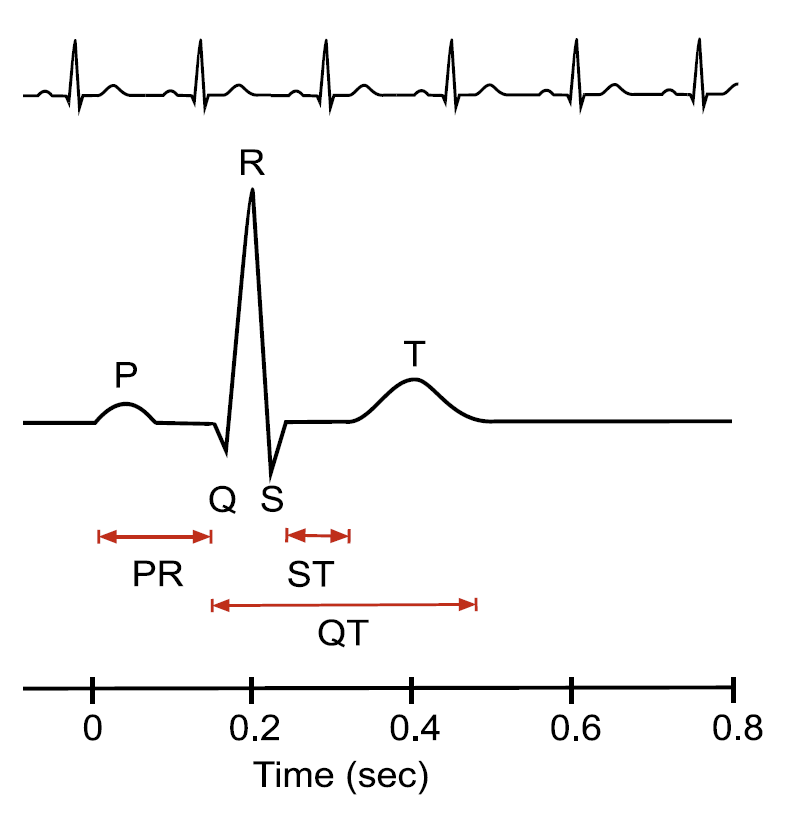Makindo Medical Notes"One small step for man, one large step for Makindo" |
|
|---|---|
| Download all this content in the Apps now Android App and Apple iPhone/Pad App | |
| MEDICAL DISCLAIMER: The contents are under continuing development and improvements and despite all efforts may contain errors of omission or fact. This is not to be used for the assessment, diagnosis, or management of patients. It should not be regarded as medical advice by healthcare workers or laypeople. It is for educational purposes only. Please adhere to your local protocols. Use the BNF for drug information. If you are unwell please seek urgent healthcare advice. If you do not accept this then please do not use the website. Makindo Ltd. |
ECG - QT interval
-
| About | Anaesthetics and Critical Care | Anatomy | Biochemistry | Cardiology | Clinical Cases | CompSci | Crib | Dermatology | Differentials | Drugs | ENT | Electrocardiogram | Embryology | Emergency Medicine | Endocrinology | Ethics | Foundation Doctors | Gastroenterology | General Information | General Practice | Genetics | Geriatric Medicine | Guidelines | Haematology | Hepatology | Immunology | Infectious Diseases | Infographic | Investigations | Lists | Microbiology | Miscellaneous | Nephrology | Neuroanatomy | Neurology | Nutrition | OSCE | Obstetrics Gynaecology | Oncology | Ophthalmology | Oral Medicine and Dentistry | Paediatrics | Palliative | Pathology | Pharmacology | Physiology | Procedures | Psychiatry | Radiology | Respiratory | Resuscitation | Rheumatology | Statistics and Research | Stroke | Surgery | Toxicology | Trauma and Orthopaedics | Twitter | Urology
Related Subjects: |ECG Basics |ECG Axis |ECG Analysis |ECG LAD |ECG RAD |ECG Low voltage |ECG Pathological Q waves |ECG ST/T wave changes |ECG LBBB |ECG RBBB |ECG short PR |ECG Heart Block |ECG Asystole and P wave asystole |ECG QRS complex |ECG ST segment |ECG: QT interval |ECG: LVH |ECG RVH |ECG: Bundle branch blocks |ECG Dominant R wave in V1 |ECG Acute Coronary Syndrome |ECG Narrow complex tachycardia |ECG Ventricular fibrillation |ECG Regular Broad complex tachycardia |ECG Crib sheets
⚡ Key Point: Although a QT interval ≥500 ms is strongly associated with a higher risk of torsades de pointes, there is no absolute "safe" lower threshold. Even modest QT prolongation can be proarrhythmic, especially when combined with bradycardia, electrolyte imbalance, or QT-prolonging drugs.

📖 About
- The QT interval represents the total time for ventricular depolarisation and repolarisation — from the start of the QRS complex to the end of the T wave. It reflects the transmural dispersion of repolarisation (epicardial–mid–endocardial differences), which underlies susceptibility to re-entrant ventricular arrhythmias. QT duration shortens with faster heart rates and lengthens with slower ones. Hence, it should be corrected for heart rate (QTc) using formulae such as Bazett’s or Fridericia’s:
QTc = QT / √(RR)(Bazett’s) - Typical normal QTc: 350–440 ms.
🩺 ECG – QT Interval
- Prolonged QT reflects delayed ventricular repolarisation.
- Abnormal QTc: >450 ms in men and >460 ms in women.
- Excessive prolongation predisposes to Torsades de pointes (TdP) — a polymorphic ventricular tachycardia that may degenerate into ventricular fibrillation.
📏 Measuring the QT
- Measure manually in the limb lead showing the clearest T-wave termination.
- From the start of the QRS to the end of the T wave; average across 3–5 beats.
- U waves should be included only if they merge with the T wave.
- In atrial fibrillation, measure several beats with similar RR intervals.
- Preferably assess during peak drug plasma levels when evaluating medication effect.
- Always adjust for heart rate before interpreting QT values.
⚠️ Causes of Long QT
| Category | Examples |
|---|---|
| Genetic |
|
| Electrolyte Disturbance |
|
| Drugs |
|
| Miscellaneous |
|
⬇️ Causes of Short QT
- Hypercalcaemia or hyperkalaemia ⚡
- Digoxin effect (“scooped” ST depression)
- β-blockers, phenytoin, or congenital short-QT syndromes
🧠 Teaching Commentary
QT prolongation represents disordered repolarisation across the ventricular wall. The mid-myocardial “M cells” are especially prone to delayed repolarisation, creating dispersion of recovery times and enabling early after-depolarisations — the substrate for torsades. Always review drugs, electrolytes, and heart rate before attributing it to a congenital cause. Even mild prolongation in a polypharmacy elderly patient can be dangerous, particularly if combined with bradycardia or hypokalaemia.